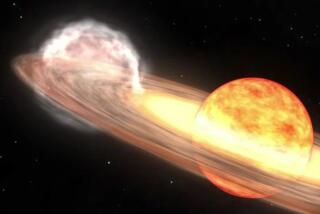Spacecraft beams new images of comet pierced by Deep Impact probe
A NASA spacecraft has begun beaming back dozens of raw images from a comet purposely hit by an earlier probe, and officials say they plan to make the pictures public throughout Tuesday morning.
The repurposed Stardust spacecraft locked eyes with the Tempel 1 comet on Valentine’s Day, coming within 112 miles about 8:39 p.m. and snapping a budgeted 72 images along the way. Its views were arriving on Earth about every 15 minutes.
Tempel 1 is the subject of an ambitious experiment. In 2005 the Deep Impact spacecraft shot an 820-pound probe into the comet to try and find out what the comet was made of. The debris from the impact effectively blocked scientists’ view of the crater at the time.
Now that the comet has completed one full revolution, scientists hope to get a good look at that crater and compare it to the comet’s other surface features.
They also want to see what’s changed since they last laid eyes on Tempel 1, said Joe Veverka, the mission’s principal investigator.
“That’s something we’ve never been able to do before,” Veverka said.
He also suggested that certain smooth areas hinted at the possibility that something may have once flowed over the comet’s surface.
Stardust snapped a picture every six seconds as it swooped past Tempel 1. Applause broke out Monday night in the viewing room at the Jet Propulsion Laboratory in La Cañada Flintridge when officials announced that the spacecraft had reached its closest approach to the comet.
Many of those attending, munching on pink-frosted cupcakes while watching the big screen showing both Lockheed-Martin Space Systems in Denver, Colo., and the inside of mission control at JPL, were relatives or friends of someone working on the project.
Such was the case for 27-year-old Ryan Glenn, whose uncle, Don Sweetnam, served as a deputy project manager. Many in Sweetnam’s family, including his grandparents and his children, showed up to watch as well.
“I think it’s really cool how there are so many people working in harmony for this little thing ,” Glenn said. He had brought his girlfriend, Liliana Lugo, 23. Lugo, who is studying to be a geologist at Cal State Los Angeles, found much in common with the science behind the mission.
“When the flow stuff came on about the comet, it was really interesting to see that it was kind of similar to geology,” Lugo said, munching on a pink cupcake and a cookie.
One highlight of the night came when mission co-investigator Steve Chesley said he had proposed to his fiancee, Jana Pittichova, earlier that day. He and Pittichova, an astronomer at the University of Hawaii, had met a year and a half ago while starting work on the Stardust-NExT project. Chesley asked Pittichova to marry him using the final slide of Monday’s morning science meeting, and presented her with a ring created by a company also named “Stardust” (whose logo is a comet, Chesley added).
“We met through the Stardust mission. And today [Monday] is the final day of the mission. And it’s Valentine’s Day. And I found this ring that’s made by the “Stardust” company,” Chesley explained. “It was such a convergence of events that I couldn’t miss the opportunity.”
The Stardust spacecraft, which previously obtained interstellar dust from comet Wild 2 and snapped images of the asteroid Annefrank, has now completed its final planned mission. Its fuel tank, once filled with hydrazine, is nearly empty.







